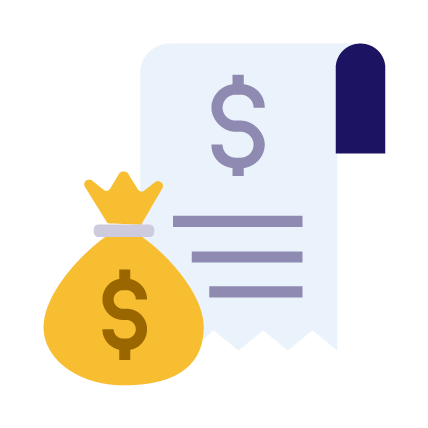When it comes to figuring out how to save for your child’s education, you have a few options.
Your friends may suggest that you take a look at a RESP, TFSA or a general savings account, but how do you know which is best? Let’s take a look at how each works and find out!
Saving with a Savings Account
Pros:
- Your principal is guaranteed
Cons:
- Funds are not invested, significantly affecting growth potential
- Not eligible for government education grants
- Interest income is taxable
One of the easiest ways to save for anything is through a traditional savings account. The idea is simple: you put money into the account and watch it grow as you continue to add to it.
When parking your money in a savings account, the account provider will often pay you a small amount of interest to use the funds. This can typically range anywhere from 0.01% to 2% annually, depending on the provider, amount saved and type of account.
There is no limit to how much you can deposit into a savings account, and your savings will typically be insured up to $100,000 by the Canadian Deposit Insurance Corporation.
Fees for the account will vary, depending on the provider, amount saved and how you use it.
The main drawbacks to using a standard savings account to build your education savings is it’s not eligible for government education grants and you often miss out on a lot of growth that you otherwise would enjoy through investing your money. You are also taxed on the money you do make off interest.
Tax-Free Growth a Tax-Free Savings Account
Pros:
- Can use as an investment account to grow savings
- Investment income earned is tax-free
- Lifetime contribution maximum of $88,000 if born before 1991
- Unlimited withdrawals at any amount
Cons:
- Not eligible for government education grants
- Cannot be opened under a beneficiary’s name until they’re 18
A tax-free savings account is a valuable tool to help families build wealth and grow their savings. Despite its name, which often deceives many Canadians, a TFSA is so much more than a standard savings account; its true value is unlocked when using it to hold stocks and bonds.
As of this year, you can contribute a lifetime maximum of $88,000 into a TFSA if you were 18 or older in 2009, and the money you make off your Canadian investments within it are considered tax-free. There’s a string attached to this feature though: while your earnings are not taxable as capital gains, in the same vein, you cannot declare capital losses in a TFSA for tax purposes. This typically makes the account ideal for stable Canadian investment products and holdings.
Fees for TFSAs can typically range depending on the provider, amount saved and whether the account is managed or self-directed.
The main drawback to using a TFSA for your education savings is it’s not eligible for educational grants from the government. Grants can often have rather substantial effects on your education savings, giving you an automatic 20% on $36,000 when strategically contributed to trigger the maximum payout.
A child is also only eligible to start a tax-free savings account at 18 and will have significantly less contribution room when first starting out. This means the majority of savings would have to come from your contribution room, which could be used for other things and may not be a convenient way of saving if you’re not the child’s parent. While you are eligible to withdraw as much as you want, when you want, doing so forfeits that contribution room for the rest of the year as well.
Paying for an Education with a Registered Education Savings Plan
Pros:
- Can use as an investment account to grow savings
- Earnings are taxed in your child’s hands when withdrawn, often resulting in little-to-no tax
- Eligible for substantial added savings through applicable federal and provincial grants
Cons:
- Meant solely for education savings
- Withdrawals subject to Canadian Income Tax Act requirements
A registered education savings plan (RESP) is an account specifically designed to help you save for your child’s future. It can be opened for your child as soon as they have a social insurance number, and you can contribute a lifetime maximum of $50,000 per beneficiary into the account.
Just like TFSAs, RESPs can hold investments and money. All income generated within a plan is tax-advantaged and deferred, meaning that you only pay taxes when withdrawing your funds, and even when you do, it’s under your child’s bracket, triggering little-to-no taxes if put towards their education.
One of the main advantages of opening a RESP is that it’s eligible for government grants. Off the bat, the government will match 20% of the first $2,500 you put into your RESP every year, giving you up to a maximum of $7,200 over the lifetime of your RESP. Depending on your household income and the province you live in, you may also be eligible for even more, like the ACESG, Canada Learning Bond, Quebec Education Savings Incentive or British Columbia Training and Education Savings Grant.
Similar to TFSA’s, fees for RESPs can typically vary depending on the provider, amount saved, investment composition and whether the account is managed or self-directed.
The main drawback to a RESP is that it’s solely meant for education savings. Should your child not pursue a post-secondary education, you can either transfer the funds to another child, put it towards your registered retirement savings plan (if you have the room) or withdraw your investment income at an elevated tax rate. Grants and grant income will always be clawed back by the government if they’re not used by your child during their education.
So What’s Best?
While each savings vehicle certainly has its benefits, and there is no one-size-fits-all approach to financial planning, we believe RESPs are the true leader in education savings.
No other investment vehicle gives you access to thousands of dollars in federal and provincial government grants, and when coupled with its tax-advantaged properties, RESPs make a very strong case to be an integral component of any education savings journey.

Embark is Canada’s education savings and planning company. The organization aims to help families and students along their post-secondary journeys, giving them innovative tools and advice to take hold of their bright futures and succeed.



